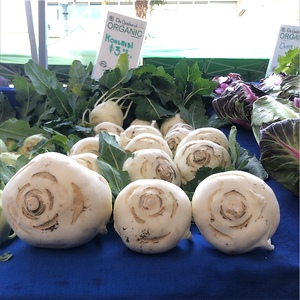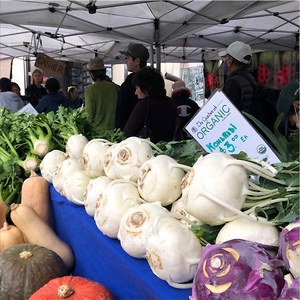


White Kohlrabi
Estimated Inventory, ea : 0
Description/Taste
White kohlrabi is a leafy, long-stemmed plant comprised of a swollen stem at the base that forms an ovate, round, to elongated bulb. The bulbs develop just above the soil, not underground, and are traditionally harvested when they are 5 to 8 centimeters in diameter. The bulb’s skin appears in shades of white, sometimes tinged with pale green, and is semi-thick, firm, and smooth with a rubbery texture. Underneath the skin, the white flesh is crisp, aqueous, and dense with a snap-like, crunchy consistency. It is important to note that the bulbs should be harvested when they are young and small, as older bulbs may develop a stringy, toothsome, and woody mouthfeel. In addition to the bulbs, White kohlrabi features several slender stems that emerge from all sides of the bulb. The stems are crisp and fibrous, also found in shades of white, are attached to dark green, elongated leaves. The broad and flat leaves are elliptical in shape and have toothed margins, a waxy feel, and prominent veining, giving the leaves a textured surface. White kohlrabi bulbs have a neutral, sweet, and subtly peppery flavor reminiscent of broccoli, turnips, or cabbage, but bulbs are much milder, lacking strong vegetal undertones. The leaves and stems are also edible and have a taste similar to collard greens or kale.
Seasons/Availability
White kohlrabi is available in the fall through early spring.
Current Facts
White kohlrabi, botanically classified as Brassica oleracea, is a cool-season annual belonging to the Brassicaceae family. The name kohlrabi is derived from the German word “kohl,” meaning “cabbage” and “rube,” meaning “turnip,” and the vegetable is native to northern Europe, where it has been historically grown in home gardens since the 16th century. White kohlrabi is a general descriptor used to encompass several white varieties, including Early White Vienna, Giant White kohlrabi, and Di Vienna Bianco. The plants mature in approximately 55 to 60 days and can grow up to thirty centimeters in height. While White kohlrabi is less common than purple or green kohlrabi, the bulbs share a very similar flavor profile and can be used interchangeably in culinary recipes. White kohlrabi is not cultivated commercially, but the plants are a popular home garden cultivar in Europe and the United States, incorporated into successive planting strategies for a prolonged harvest. The bulbs, leaves, and stems are edible and can be found in markets sold altogether, or the bulbs can be separated from the leaves and stems for improved shelf life.
Nutritional Value
White kohlrabi is an excellent source of fiber to regulate the digestive tract and vitamin C to strengthen the immune system, boost collagen production, and reduce inflammation. The bulbs also provide vitamin B6 to guard against sickness and regulate amino acid levels in the blood, manganese to develop connective tissues, potassium to balance fluids within the body, and other amounts of folate, magnesium, copper, and phosphorus.
Applications
White kohlrabi is a versatile vegetable that can be consumed raw or incorporated into cooked preparations. The leaves, stems, and bulbs are edible, and when raw, the bulbs are typically peeled and tossed into salads and slaws. White kohlrabi is also sliced into pieces and served with dips on appetizer platters, thinly sliced and sprinkled with lemon juice, sea salt, or olive oil, or spiralized and served as a pasta substitute. In addition to fresh preparations, White kohlrabi develops a soft and tender texture when cooked and can be simmered into soups, stews, and curries. The bulbs can also be steamed and mashed as a side dish, roasted to develop a caramelized nature, or sauteed and served with roasted meats. The bulbs hold their shape well when baked and can be stuffed with grains, meats, and minced vegetables. They can also be finely sliced and used as a pizza topping, mixed into grain bowls, pureed into sauces, or pickled for extended use. Beyond the bulbs, the leaves and stems can be chopped into stir-fries or boiled into stocks and broths. White kohlrabi pairs well with herbs such as chives, parsley, and tarragon, meats such as beef, pork, and poultry, seafood, coconut, carrots, leafy greens, cabbage, parmesan, lemon juice, and spices such as paprika, nutmeg, turmeric, and garam masala. Whole, unsliced White kohlrabi bulbs will keep up to one month when stored in the crisper drawer in the refrigerator. The leaves and stems wilt quickly and should be used immediately for the best flavor and texture.
Ethnic/Cultural Info
In Germany, there is a variety of kohlrabi known as Superschmelz that can reach over 25 centimeters in diameter. The cultivar is also known as Giant White kohlrabi or Gigante and was first developed in the German municipality of Schmelz. Superschmelz is the largest kohlrabi cultivar, weighing anywhere between 10 to 22 pounds, and despite its enormous size, the variety remains crisp, tender, and edible. Superschmelz can also be used interchangeably with smaller kohlrabi types in recipes and are popularly incorporated into soups, stews, and roasted side dishes. One of the most common kohlrabi preparations in Germany is boiled kohlrabi tossed in a creamy white sauce. The rich side dish is served with meats such as frikadellen, a German meat patty eaten hot or cold. Superschmelz kohlrabi can also be sliced into cutlets, coated in breadcrumbs and crushed almonds, and browned to create vegetarian schnitzel.
Geography/History
Kohlrabi is native to Northern Europe and was developed sometime before the 16th century. Experts believe the swollen bulbs are descendants of a wild marrow cabbage, a non-heading plant with a fleshy, succulent stem. The first written record of the plant was documented in 1554 by botanist Matthiolus, and by the late 1500s, kohlrabi had been spread throughout Europe. Kohlrabi was planted commercially in England in the 1840s and 1850s, and it was also brought to the United States sometime around 1806, commercially grown in the 1860s through 1880s. White kohlrabi has been in existence since the discovery of the vegetable, and there are several heirloom varieties in cultivation that can be traced back to at least the 19th century. Today White kohlrabi is grown worldwide and is cultivated in Southeast Asia, Europe, and North America. When in season, the cool-crop vegetable is sold through farmer’s markets, grocers, and specialty distributors.















